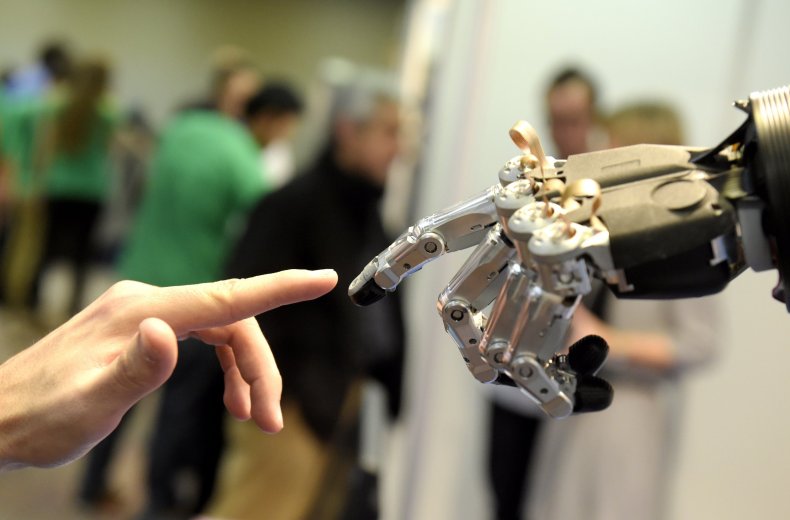https://www.newsweek.com/brain-augmentation-human-super-intelligence-cyborgs-future-625507
For most people, the idea of brain augmentation remains in the realms of science fiction. However, for scientists across the globe, it is fast becoming reality—with the possibility of humans with “super-intelligence” edging ever closer.
In laboratory experiments on rats, researchers have already been able to transfer memories from one brain to another. Future projects include the development of telepathic communication and the creation of “cyborgs,” where humans have advanced abilities thanks to technological interventions.
Scientists Mikhail Lebedev, Ioan Opris and Manuel Casanova have now published a comprehensive collection of research into brain augmentation, and their efforts have won a major European science research prize—the Frontiers Spotlight Award. This $100,000 prize is for the winners to set up a conference that highlights emerging research in their field.
Project leader Lebedev, a senior researcher at Duke University, North Carolina, said the reality of brain augmentation—where intelligence is enhanced by brain implants—will be part of everyday life by 2030, and that “people will have to deal with the reality of this new paradigm.“Their collection, Augmentation of brain function: facts, fiction and controversy, was published by Frontiers and includes almost 150 research articles by more than 600 contributing authors. It focuses on current brain augmentation, future proposals and the ethical and legal implications the topic raises.
“Brain augmentation is basically an idea to use technology to improve the brain of a normal person or repair the brains of a people with neurological conditions,” Lebedev tells Newsweek.
There are three main approaches to doing this. The first involves recording information from the brain, decoding it via a computer or machine interface, and then utilizing the information for a purpose.
The second is to influence the brain by stimulating it pharmacologically or electrically: “So you can stimulate the brain to produce artificial sensations, like the sensation of touch, or vision for the blind,” he says. “Or you could stimulate certain areas to improve their functions—like improved memory, attention. You can even connect two brains together—one brain will stimulate the other—like where scientists transferred memories of one rat to another.”
The final approach is defined as “futuristic.” This would include humans becoming cyborgs, for example, and would raise the ethical and philosophical questions that will need to be addressed before scientists merge man and machine.
Lebedev said these ethical concerns could become real in the next 10 years – 2027, but the current technology poses no serious threat.
“I guess some people may think it is dangerous,” he says. “But this is actually exactly why we organized this topic. We wanted to cover the issues scientifically, particularly papers that provide a snapshot of the current situation.
“Probably the biggest thing to overcome ethically is whether you can you interfere with somebody’s consciousness. Of course nobody knows what consciousness is, but ethically it is clear—you don’t want to interfere with a person to the extent that their consciousness or individuality can change.”
One of the studies, which used pharmacological approaches to augmentation, helped improve brain function temporarily, but this led to changes to the brain. “Should you be allowed to do this or not?” he says.
When it comes to human super intelligence, brain augmentation does not necessarily mean the creation of Professor X-type people. Instead (at least for now), it relates to improving things like memory and concentration, while developing ways to treat people with sensory disabilities—for example, restoring the sense of touch to a person who has been paralyzed.

A man moves his finger toward a robotic hand at the IEEE-RAS International Conference on Humanoid Robots in Madrid on November 19, 2014.AFP
RELATED STORIES
- Magic Leap Gives Glimpse Into Augmented Reality Future
- AI Could Take All of Our Jobs by 2060
- 3D-Printed ‘Skin’ Could Help Create Bionic Superhumans
“The brain produces many capacities—it produces consciousness,” Lebedev says. “But at the same time, computers can do some things much better than the brain. They do it differently. For example, they play chess better, they do mathematical calculations better, they even can memorize better. So probably in the near future giving humans super intelligence would be enlarging capacities of the human brain.
“I do not necessarily see it as a direct interface of these devices to the brain. There are still many areas to develop now using normal sensors—you can have glasses that augment reality and so on. First of all, we will see sensory augmentation. Sensory disabilities will no longer be a problem. If a person is blind then there will be ways to restore vision. Or if a person is paralyzed and can’t feel, sensations will be restored.”
He said at some point in the future this augmentation may turn into a direct interface, “or exo-brain”, embedded into the organ, but this is at least 20 years away from being real. “Beyond that we can speculate that maybe there will be brain to brain communications, so you can connect to another person and exchange thoughts directly. But this is unlikely to happen for another 20 years from now, maybe 50 years.”
Lebedev’s personal research interests lie with brain-machine interfaces. For his own hopes for brain augmentation, he says he would like to see a device that can be fully implanted into the brain. At the moment, scientists do not have the technology to create interfaces in this way and the implant would need to get a power source—which is “one of the biggest problems”—and would need to have a wireless communication system included.
For now, it is a case of waiting for the technology to progress. “You will be amazed by how much we will have advanced in 2030,” said Opris, Lebedev’s co-editor on the project. “There are as many possibilities as the imaginations of researchers.”
